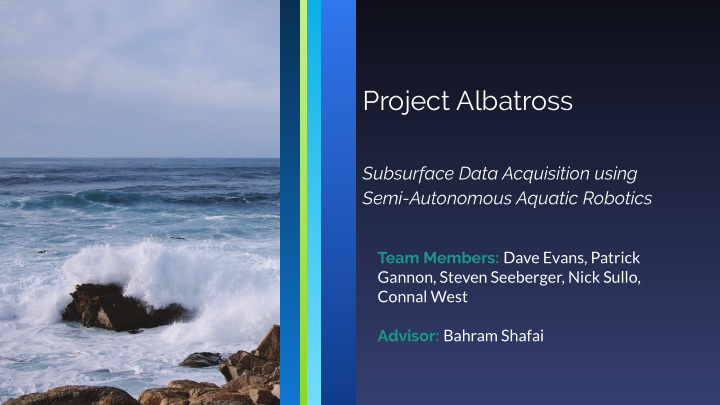



Project Albatross Subsurface Data Acquisition using Semi-Autonomous Aquatic Robotics Team Members: Dave Evans, Patrick Gannon, Steven Seeberger, Nick Sullo, Connal West Advisor: Bahram Shafai
The Team Connal West Steven Seeberger Dave Evans Nick Sullo Patrick Gannon
Approximately 40% of the lakes in America are too polluted for fishing, aquatic life, or swimming
Problem Formulation Monitoring water quality is becoming increasingly ➝ important with rise of … ⇾ Water pollutants (plastics, chemicals, etc.) ⇾ Climate change (causing ocean acidification) ⇾ Extreme weather patterns Marine biologists mainly rely on manual data capturing ➝ ⇾ Data sparsity ⇾ Aliasing issues ⇾ Mostly vertical profiles ⇾ Time/Cost of Measurements
Project Albatross
Design Solution Create an autonomous ➝ watercraft Obtain underwater ➝ measurements at various depths Able to relay data/route ➝ updates to user mid-mission Process and present data in a ➝ digestible manner
System Architecture
Unmanned Surface Vehicle (USV) Custom aluminum frame, ➝ custom pontoons, sealed electric housings 6 modified bilge pumps ➝ powered by two 12V SLA batteries Pixhawk flight controller ➝ RaspberryPi ➝
Autonomous Underwater Vehicle (AUV) Sensors: pH, turbidity, dissolved ➝ oxygen, temperature, and depth Stepper motor/ syringes adjust ➝ buoyancy 2 integrated Arduinos for: ➝ ⇾ Sensor Data ⇾ Buoyancy Control
Data Processing Processes sensor data in ➝ real time Visual sensor data using: ➝ ⇾ Line Charts ⇾ Point Charts ⇾ Heat Maps Provides holistic view of ➝ mission data
Overall Results 2 missions: surface and 2 meter ➝ depth Able to perform variety of ➝ mission paths and return to “home” location successfully Transfer data and commands ➝ from shore to sub with various sub depths Data viewed/processed in ➝ real-time in Mission Planner and exported to CSV
Video Demonstration
Acknowledgements Professor Shafai, capstone advisor ➝ Ethan Edson, researcher at the Marine Science ➝ Center DFRobot ➝ Northeastern EECE Capstone Department ➝ Home Depot Staff ➝
Questions?
Thanks!
Recommend
More recommend